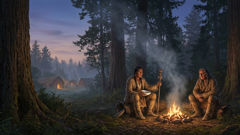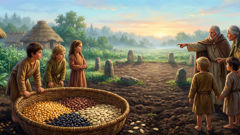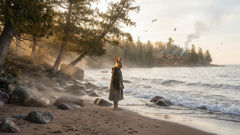Introduction
Beneath a sky that shifts from cobalt to the pale gold of dawn, the story of María Lionza begins where river meets mountain and the wind remembers the footfalls of the first people. She arrives in song and in silence: a woman who is also a spirit, a queen of the wild, an emissary of reconciliation between human longing and the patient laws of nature. In Venezuela the name María Lionza conjures lowland palms and clouded crests, the damp hush of caverned rivers, and open fields where cattle graze under a forgiving sun. She is summoned with flowers, horses, cigars, fruit, and prayer; she is found in the flash of a bird that calls across a ravine or in the careful step of a healer tracing patterns in dust. There is no single origin: indigenous myths braided with African spiritual practice and Iberian saints' narratives, each thread adding texture without erasing the others. Pilgrims climb toward her mountain and mothers whisper her name to children on hot afternoons. Where strangers meet in marketplaces or fishermen untangle nets at dawn, the language of María Lionza shapes itself anew—always attentive to the ache of loss, the hunger for justice, the quiet desire for peace. This is a tale of rivers and rituals, of love and protection, of the living landscape that holds and is held. It is meant for the traveler who wants to know why people carry offerings in woven baskets, for the curious reader who wants to hear how folklore adapts to cities and radios, and for anyone who believes that sacredness can be spoken by the wind through the treetops. Read on to walk the paths of devotion, to meet the spirits who accompany this goddess, and to learn how María Lionza continues to shape Venezuelan identity in ways both subtle and monumental.
Origins and the Many Faces of María Lionza
María Lionza enters the story like a river that has known many beds. Her earliest gestures belong to oral memory: an indigenous woman allied with the forest, a spirit of mountain and water who watches the cycles of birth and harvest. In indigenous traditions across what would become Venezuela, female nature spirits were guardians of game, keepers of springs, and teachers of plant lore. They were not distant divinities but part of an everyday sacred ecology, invoked to bless a hunt or to calm a storm. When African peoples arrived through the brutal networks of forced migration, they brought a pantheon of spirits that emphasized ancestral power, healing, and the negotiation of suffering. When Iberian colonizers brought saints and Marian devotion, a third thread braided into the growing pattern of belief. María Lionza stands at the seam of these crossings: she is María by name, echoing the Christian Virgin; she is Lionza, a name that suggests strength, a wildness that belongs to the land as much as to any story.

In many accounts she is described as a queen—regal, tranquil, and implacably connected to the animals and plants of the terrain. In others she is a mountain woman who loved, who lost, and who refused to be broken by grief. Sometimes she is a seductive presence who tempts fishermen and hunters to respect the limits of their craft; in other versions she is a mediator who gathers lost souls and returns them to belonging. This plurality is crucial: María Lionza is less a single biography than a constellation, a set of possibilities whose contours shift with region and time. In Lara and Yaracuy, in the central highlands and among coastal communities, practices differ in attire, in offerings, and in the songs that rise by candlelight. Each community claims a piece of her and, by claiming, keeps her alive.
The landscape of Venezuela itself—the tropical lowlands, the tepui mesas, the cloud forests of the cordillera—has shaped how people envision María Lionza. Mountains demand reverence; rivers make you speak to them. A legend that grows among these features will always be animated by the same elements: water, stone, wind, and the wild breath of fauna and flora. Indigenous healers remember plants by Latin names and songs; they teach that María listens most clearly when offerings are placed at a river's lip or beneath the trunk of a great tree. The offerings may be simple—flowers, fruits, new kerchiefs—or complex, involving music and the giving of one's own prayers in a language that changes from valley to valley. In all such rituals, the intent matters more than extravagance. People who come to María are often ordinary: a woman seeking a child's health, a man asking for fair weather for his crop, a family seeking reconciliation after a feud. She is generous in an ecological rather than transactional way: she restores the balance that allows life to persist.
To understand María Lionza is to understand syncretism in motion. Colonial and postcolonial histories cannot be separated from the practices that form around her. For enslaved Africans and for indigenous people confronting the erasure of language and place, María became a channel for continuity and resistance. She allowed displaced communities to preserve rituals under new names and to insist on sacredness despite the pressures of modernity. In contemporary Venezuela the legend of María Lionza persists through popular media, murals, radio programs, and the steady stream of pilgrims who climb toward her sanctuaries. She is invoked at funerals and at carnival, in courts of law and in private kitchens. Her acceptance of many faces is a source of resilience; when a people must adapt, their gods adapt too.
When scholars trace María's past they find archival references, folk tales collected by anthropologists, and living practices that may not appear in any book. What matters to devotees is present experience: the way a curandera (healer) sets herbs in a circle and calls María's name, the sound of tambour and flute in a night ceremony, the sudden peace that can settle over a family after an offering is accepted. In each of these moments legend and life converge. María Lionza becomes less an abstract symbol and more an active presence that continues to reconfigure how Venezuelans relate to each other and to the land.
This plural origin makes María Lionza especially relevant to anyone studying the survival of folk traditions. Her story is a living example of how belief systems borrow and recombine, how people draw power from ancestral memory and present need. She is both anchor and sail: a rooted guardian and a forward-moving figure who accepts new prayers and new songs. In a world becoming more urban and more interconnected, the legend of María Lionza reminds communities that reverence for nature and insistence on social harmony can survive—and even flourish—when given room to change.
Pilgrimage, Rituals, and the Living Community
To follow María Lionza today is to embark on a pilgrimage that is both physical and symbolic. The most famous pilgrimage is to Sorte Mountain, where thousands have traveled for decades to seek healing, counsel, and deliverance. Pilgrims come on foot, in buses, on horseback, and sometimes with small children asleep in their arms. The road is a communal artery: strangers become companions, sharing food and stories beneath the canopy or at roadside chapels. Offerings change with the seasons and with personal need—bouquets of white and yellow flowers for peace, bottles of rum for gratitude, horses' trappings for those seeking protection in travel. The language of ritual is not codified; rather, it grows organically from gestures that invite presence. Candles are lit not as theatrical props but as persistent, fragile pleas kept alight by many hands.

Ceremony is rarely a spectacle without meaning. The curandero or espiritista often acts as guide, mediating between the supplicant and María's retinue of spirits. The retinue is a vivid gallery: warrior spirits who protect, indigenous guardians who instruct in plant lore, African ancestors who provide resilience, and mysterious spirits who bring messages from the unseen. Each spirit can be called upon for particular dilemmas. In the circle of ritual, names are spoken and music calls. Drums beat with a heartbeat cadence, flutes trace ancient patterns, and singers chant lines that loop like river eddies. Those who stand in the ring may be asked to tell their story, and this sharing is an act of transformation. A person who confesses grief or fear in ritual does not only seek an answer; they enter a space where community holds them while the spirit listens.
The healing practices tied to María Lionza are both spiritual and practical. Plant knowledge is integrated with prayer; teas and poultices may be paired with offerings. The healer may instruct a patient in diet or in how to care for a wound, then call upon María to seal the treatment with a blessing. In some cases divination is used: shells, cards, or the flight of birds carry meaning that an experienced reader interprets. These practices persist not because they oppose modern medicine but because they address needs that clinics sometimes cannot—explanations for misfortune, resolution of longstanding family tensions, or rites that bind a community after loss. People often navigate both systems: a mother may consult a pediatrician for a child's fever and then bring the child to a curandero for spiritual protection. The coexistence of these approaches is not incidental; it demonstrates the adaptability of belief to human complexities.
Ritual spaces vary. Some ceremonies take place in wild places where the earth itself feels like witness; others happen in private homes or under temporary awnings in city squares. Music and dance are essential: they conjure a rhythm that allows participants to shift states and to sense María's presence. Dance is not mere entertainment; it is a language of the body used to express respect, petition, and gratitude. The steps may be improvised, shaped by the dancer's needs, and yet they belong to a shared vocabulary. In this way ritual connects individual narratives to a communal pattern, and people who have never met before can find themselves aligned in movement and intention.
The social dimension of María Lionza's devotion is striking. Festivals create networks of mutual aid; when one family faces illness or the loss of a home, others often respond with food, labor, or offerings. This reciprocity is an ethic embedded in the practice: devotion that looks inward and outward simultaneously. In times of political or economic crisis, public rituals have served as spaces of solace and of quiet resistance. Invoking María's name during such moments affirms continuity: a declaration that the world contains sources of support beyond the immediate pressures of governance or market forces.
Yet there are tensions too. The commodification of pilgrimage, the exploitation of sacred sites, and the contest over who 'owns' María's story have sparked debate. Tourism can bring needed income to communities, but it can also pressure sacred protocols. Local leaders and spiritual authorities often negotiate boundaries: what may be photographed, where offerings may be placed, which ceremonies remain private. These conversations reveal the negotiation between preservation and openness, a negotiation that respects the integrity of living traditions while allowing them to speak to a larger world.
Because María Lionza is a syncretic figure, she is also contested in the public imagination. Different political movements have sought to harness her symbolism—some highlighting her as a symbol of national identity, others as an emblem of resistance to exploitation. Regardless of rhetoric, devotion continues on the ground in forms that often defy simple classification. Families continue to bring offerings, curanderos continue to teach, and pilgrims continue to climb. The popularity of María Lionza does not dilute her meaning; instead, it multiplies it, giving rise to personal stories that are as diverse as the ecosystems she protects.
In the end, pilgrimage and ritual under María Lionza's aegis are about relationship. They teach that human life depends on a network of obligations to land, to ancestors, and to neighbors. They offer a model of care that is ecological and communal, a worldview where the smallest act—placing a flower on a riverbank, telling the truth before witnesses, sharing a meal with a stranger—becomes a stitch in a larger garment of belonging. For those who seek her, María does not promise a life without sorrow. She offers, instead, a way to bear sorrow with dignity, to call upon a lineage of spirits and people who will accompany you through hardship and toward peace.
Conclusion
The legend of María Lionza endures because it is not a single, fixed text but a living conversation between people and place. She remains a presence that responds to weather, grief, joy, and the small ethical choices that shape daily life. In contemporary Venezuela, where landscapes and communities face economic, political, and environmental pressures, María's continuing relevance speaks to the human need for guardianship and for rituals that imaginatively protect what matters. Whether invoked by a rural farmer before planting season or by a city family lighting a candle on a kitchen altar, María Lionza is a reminder that harmony can be sought in humble acts: tending a stream, speaking kindly, reconciling differences, and recognizing that every living thing has its place in a fragile balance. To tell her story is to acknowledge the ways communities hold fast to ancestral knowledge while adapting to new realities. It is to celebrate resilience without romanticizing hardship, to honor complexity rather than flatten it. Most of all, the legend encourages a practice of attention—toward rivers, toward forests, and toward one another—so that a nation, and the people who make it, might keep finding peace.













